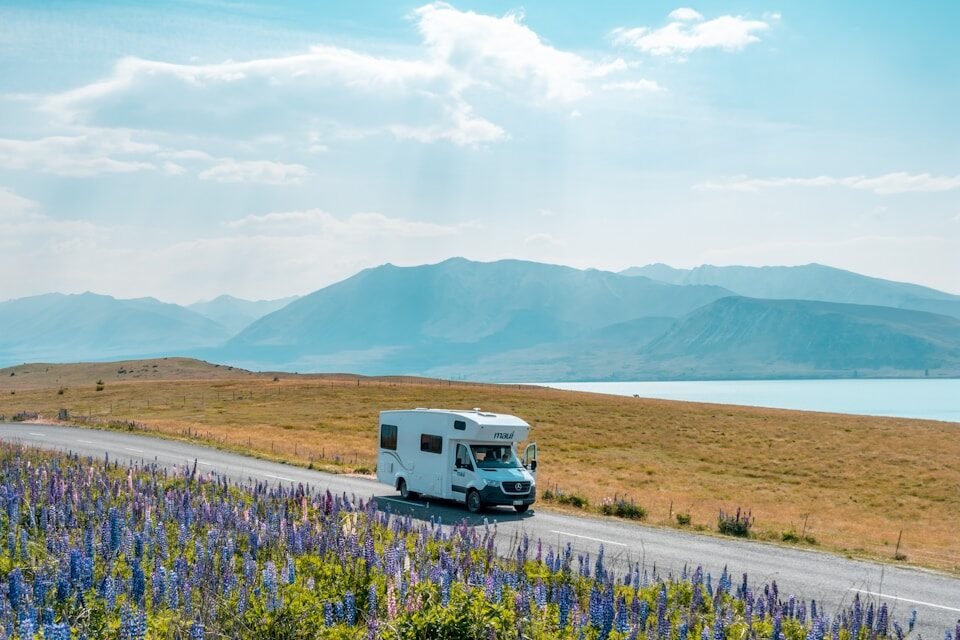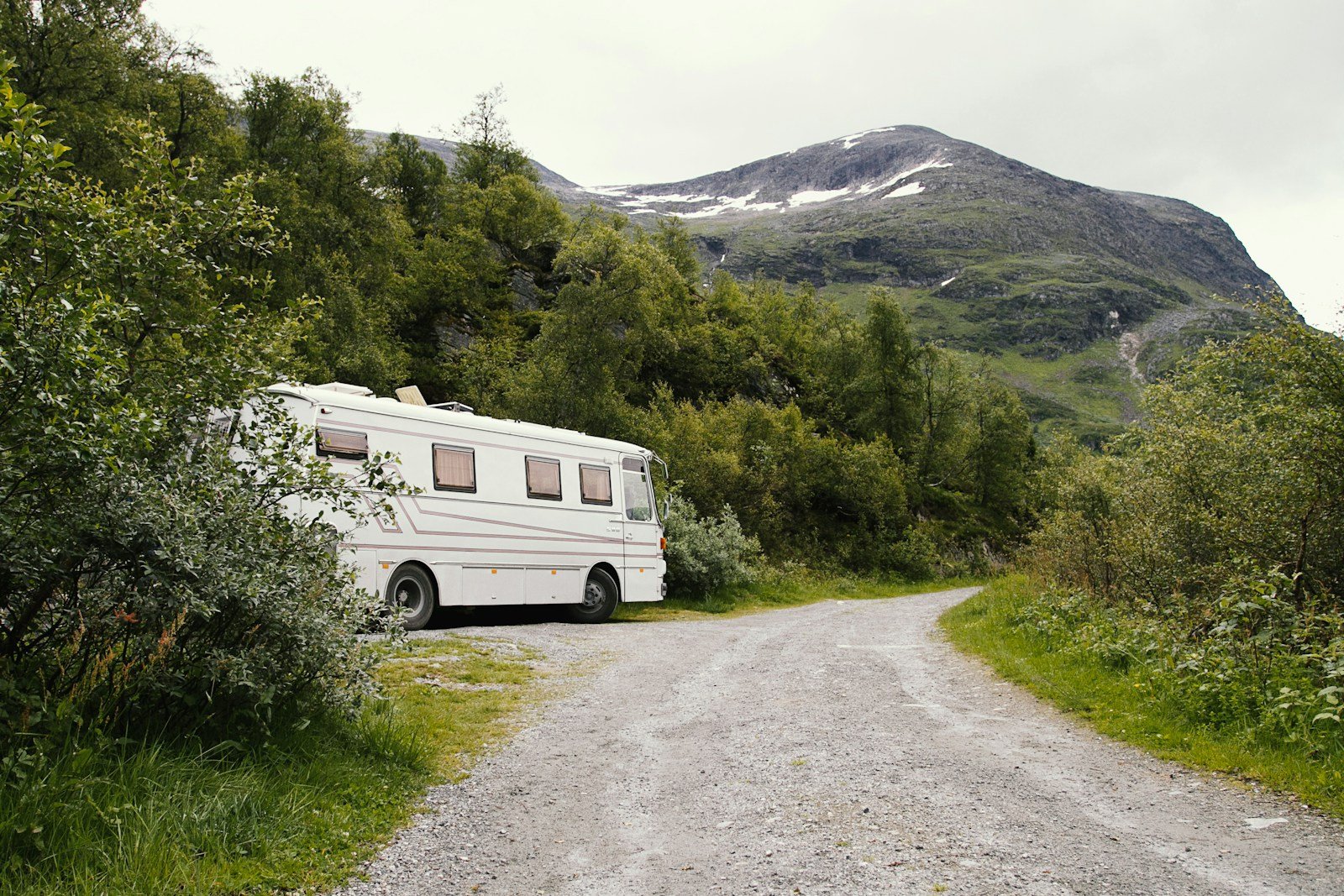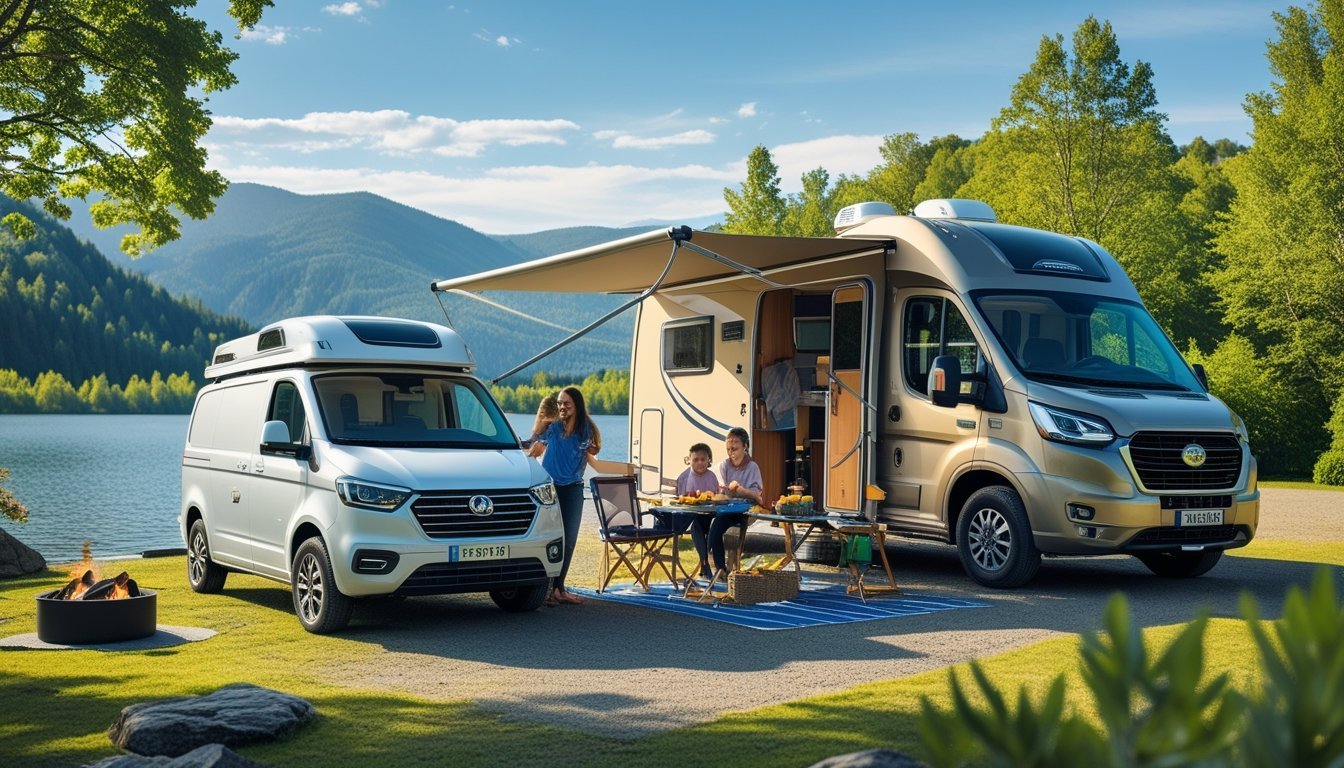Campervan or RV? Choosing between a campervan and an RV involves weighing different factors that match your travel style and needs. Both vehicles offer the freedom to explore while bringing your accommodations along, but they differ significantly in size, price, and features.

The decision between a campervan and an RV depends primarily on the type of trip you want to experience and your specific requirements for space, comfort, and mobility. Campervans (classified as Class B RVs) provide better fuel efficiency and maneuverability, making them ideal for travelers who value quick, efficient trips and easier parking. They’re typically less expensive upfront but offer limited space.
Traditional RVs, including Class A motorhomes and fifth wheels, provide much more living space and amenities. They’re better suited for longer trips or full-time living, offering separate bedrooms, full bathrooms, and more storage. However, this extra comfort comes with a higher price tag—motorhomes typically start at $50,000 even when used—and they can be challenging to drive and park in certain locations.
Understanding Campervans and RVs
When planning your next road adventure, knowing the difference between campervans and RVs is essential. These two popular mobile living options have distinct features that cater to different travel styles and comfort needs.
What Is a Campervan?
A campervan (also called a camper van) is a compact vehicle typically converted from a standard van. These vehicles offer basic amenities in a small, efficient package. Most campervans include:
- A sleeping area
- Basic cooking facilities
- Minimal storage space
- Sometimes a small toilet or portable shower
Class B motorhomes are technically campervans, though they often have more amenities than standard conversions. Popular brands like Roadtrek offer campervan options with clever space-saving designs.
Campervans excel at maneuverability and fuel efficiency. They’re perfect for weekend getaways, short trips, and travelers who prefer a minimalist “van life” approach. Their smaller size makes them easier to drive and park in regular spaces.
What Is an RV?
RV (recreational vehicle) is a broader term covering larger mobile living spaces designed for comfort and extended travel. RVs come in several classes:
- Class A: Large bus-shaped motorhomes with extensive amenities
- Class C: Medium-sized with an over-cab sleeping area
- Travel trailers: Towable units requiring a separate vehicle
- Fifth wheels: Large towable units that connect to pickup trucks
- Truck campers: Units that sit in pickup truck beds
RVs typically include full bathrooms, kitchens, sleeping areas, and living spaces. Luxury RVs often feature multiple slide-outs, entertainment systems, and residential-style appliances.
They’re ideal for long-term travel, full-time living, or families needing more space. Many RVs, like Airstream trailers, provide home-like comfort but require more planning for parking and maneuvering.
Comparing Core Features

When deciding between a campervan and an RV, several key features will impact your travel experience. These features affect your comfort level, driving experience, and overall convenience while on the road.
Living Space and Comfort
RVs offer significantly more living space than campervans. Most RVs include dedicated sleeping areas, full bathrooms, and kitchens with standard-sized appliances. This extra space allows for comfortable movement inside the vehicle and provides a more home-like atmosphere.
Campervans, in contrast, maximize limited space through clever design. Many feature convertible beds, compact kitchenettes, and minimal bathroom facilities (if any). Some modern campervans use space-saving innovations like fold-away tables and swivel seats.
Storage space is another critical difference. RVs typically include ample cabinet space, wardrobes, and exterior compartments for gear. Campervans require more strategic packing, with limited overhead storage and sometimes under-bed compartments. (Publisher may earn a commission from links in this article)
For long-term travel, the additional comfort of an RV becomes more valuable. Short weekend trips might be perfectly comfortable in a campervan’s cozier setting.
Ease of Driving and Handling
Campervans excel in maneuverability and handling. Built on van chassis, they drive similarly to regular vehicles, making them easier to navigate through city streets, tight parking lots, and winding roads. Most drivers adapt quickly to driving a campervan with minimal practice.
RVs require more driving skill and awareness. Their larger size creates significant blind spots and makes tight turns challenging. Parking often becomes a careful process rather than a simple task. Wind sensitivity also increases with the larger profile of RVs.
Many campervans feature four-wheel drive capabilities, allowing them to handle off-road conditions and reach remote locations that would be inaccessible to larger RVs. This flexibility opens up more camping options in natural settings.
Daily setup with campervans is minimal – often just parking is sufficient. RVs typically require more setup time with leveling, hookups, and slide-out extensions.
Power and Utilities
RVs generally offer more robust power systems. They usually come equipped with larger battery banks, generators, and more substantial propane tanks. This allows for extended periods of off-grid camping with full use of appliances and climate control.
Most RVs include full bathrooms with showers and flushing toilets. They also feature larger freshwater tanks and gray/black water storage, reducing the frequency of filling and emptying.
Campervans typically have more limited power capabilities, though many modern designs incorporate solar panels and efficient lithium battery systems. Their water systems are compact, with smaller tanks requiring more frequent refilling.
Climate control presents another difference. RVs offer full heating and air conditioning systems, while campervans might rely on more basic systems or portable units. The smaller space of campervans does make them quicker to heat or cool when systems are running.
Cost Considerations

Money matters when choosing between a campervan and an RV. Your budget affects both what you can buy initially and what you’ll spend over years of ownership.
Initial Purchase Price
Campervans typically cost less than full-sized RVs. New campervans range from $60,000 to $150,000 depending on features and build quality. Budget-friendly conversion vans might start around $30,000 if you’re willing to get something used or with fewer amenities.
RVs generally have higher price tags. Class A motorhomes (the large bus-style ones) can cost $100,000 to $500,000 new. Class C motorhomes (built on truck chassis) range from $50,000 to $200,000.
Used options reduce these prices significantly. A pre-owned campervan might cost $20,000-$70,000, while used RVs range from $30,000-$150,000 depending on size, age, and condition.
The price difference reflects the additional space and features in RVs, including:
- Larger living areas
- More storage capacity
- Additional amenities like slide-outs
- More complex systems
Ongoing Maintenance and Repairs
Campervans generally have lower maintenance costs. Their automotive components match standard vans, making parts more readily available and repairs less specialized. Annual maintenance might cost $500-$1,500.
RVs have more complex systems requiring specialized service. Their maintenance includes both automotive components and residential systems like:
- Plumbing networks
- Larger electrical systems
- Hydraulic slide-outs
- Generator maintenance
RV repairs often require specialized technicians, increasing labor costs. Annual maintenance for RVs typically ranges from $1,000-$3,500 depending on size and complexity.
Insurance costs also differ. Campervan insurance might cost $800-$1,200 annually, while RV coverage can range from $1,000-$4,000 depending on value and usage type.
Fuel Efficiency and Economy
Fuel costs represent a significant ongoing expense. Campervans generally achieve better fuel economy, averaging 15-22 mpg depending on size and engine type. Their smaller, more aerodynamic profile contributes to this efficiency.
RVs consume significantly more fuel. Class A motorhomes typically get 7-13 mpg, while Class C units might achieve 10-15 mpg. This difference becomes substantial on long trips.
For perspective, a 1,000-mile journey might cost:
- Campervan: $180-$250 in fuel
- Class C RV: $250-$380 in fuel
- Class A RV: $300-$550 in fuel
Engine type matters too. Diesel engines typically offer better efficiency and longevity but cost more initially. Modern campervans with efficient engines provide the best economy for long-term travelers.
Travel and Lifestyle Factors

Your travel plans and lifestyle preferences play a crucial role in deciding between a campervan and an RV. These factors will determine which vehicle provides the right balance of comfort, flexibility, and practicality for your specific needs.
Suitability for Different Types of Trips
Campervans excel at short, spontaneous adventures. Their compact size makes them ideal for weekend getaways and road trips where you’ll be moving frequently between destinations. Brands like Roadtrek offer surprisingly comfortable options in a smaller package.
RVs shine on longer journeys where comfort is a priority. With more living space, larger beds, and full bathrooms, they provide a home-like experience that reduces travel fatigue. This makes them better suited for extended trips or seasonal travel.
Consider your typical trip duration:
- Weekend trips: Campervan advantage
- Week-long vacations: Either option works
- Month+ journeys: RV advantage
Your driving comfort also matters. Campervans handle more like regular vehicles, while larger RVs require adjustment to their size and turning radius.
Campground and Boondocking Options
Campervans offer tremendous flexibility for overnight stays. Their discreet profile allows for stealth camping in urban areas where RVs would draw attention. They can access remote boondocking sites on rough roads that might challenge larger vehicles.
RVs typically require more formal accommodations. They’re perfectly suited for:
- Full-hookup campgrounds
- RV parks with amenities
- Designated camping areas
Boondocking (camping without hookups) is possible with both options but requires different approaches. Campervans need less power and water but offer limited storage. RVs provide more comfort while boondocking but may need:
- Larger solar systems
- More water storage
- Generator backup
The campground experience differs too. RVs create a more established base camp, while campervans maintain mobility for daily excursions from your campsite.
Flexibility and Versatility

When choosing between a campervan and an RV, flexibility and versatility often become deciding factors. These aspects impact how you’ll use your travel vehicle and where you can take it.
Towing and Vehicle Setup
Campervans offer superior flexibility in terms of setup. They’re ready to go without additional preparation – just park and you’re set up for the night. No need to level, connect utilities, or extend slide-outs.
RVs typically require more setup time. Larger motorhomes need proper leveling and hookups. Travel trailers demand even more work since they must be unhitched from your pickup truck before use.
For towing capabilities, RVs have the advantage. Many larger motorhomes can tow small vehicles for local transportation once you’ve set up camp. Campervans rarely have sufficient towing capacity for anything beyond small trailers or bike racks.
The “all-in-one” nature of campervans means less setup hassle but more limited options for separate transportation at your destination.
Storage and Parking
Storage space differs significantly between these vehicles. RVs provide abundant storage with basement compartments, overhead cabinets, and sometimes even exterior storage bays for bulky items like chairs and grills.
Campervans maximize limited space with clever storage solutions but simply can’t match RVs for overall capacity. Every inch serves multiple purposes in a campervan.
Parking ease is where campervans truly shine. Their compact size allows them to fit in standard parking spaces, navigate city streets, and access remote locations that larger RVs can’t reach.
RVs require special consideration for parking. You’ll need designated RV spots at campgrounds and may face restrictions in national parks, cities, and some scenic routes due to size limitations.
For everyday convenience, campervans can serve as both travel vehicle and daily driver, eliminating the need to maintain multiple vehicles.
Rental and Ownership Options
When considering a campervan or RV for your travels, you’ll need to decide whether renting or buying makes more sense for your situation. The financial implications and usage patterns play key roles in this decision.
Renting a Campervan or RV
Renting offers flexibility without long-term commitment. Basic RVs and campervans typically cost between $75-$200 per night, with prices varying based on season, vehicle type, and rental duration.
Additional fees often apply for insurance, mileage, and other extras, potentially pushing costs above $100 per day. This can add up quickly for longer trips.
For travelers who only plan 1-2 trips annually, renting is usually more cost-effective than buying. You can also try different vehicle styles before committing to a purchase.
Renting allows you to pick up vehicles in different locations, eliminating the need to drive cross-country from your home base. This saves time and reduces wear on a personal vehicle.
Stationary rentals offer another option for those who prefer staying in one location. These “glamping” options range from $100-$400 nightly, often including the campsite fee.
Making the Right Choice for You
Deciding between a campervan and an RV requires careful consideration of your specific travel needs and lifestyle preferences. The right choice will depend on several key factors that impact your road trip experience.
Factors to Consider for Your Decision
Travel Style and Duration Think about how you plan to use your vehicle. For weekend getaways and shorter trips, a campervan offers simplicity and ease of use. For extended travel or full-time living, an RV’s spacious interior and amenities provide more comfort.
Budget Constraints Campervans typically cost between $30,000-$50,000, while RVs start around $100,000. Consider not just the purchase price but also fuel efficiency, maintenance costs, and insurance rates.
Parking and Maneuverability Campervans fit in standard parking spaces and are easier to drive in cities and on narrow roads. RVs require special parking considerations and more driving skill but offer stability on highways.
Desired Amenities RVs include full bathrooms, kitchens, and separate sleeping areas. Campervans have more basic facilities but clever designs maximize limited space.
Off-Road Adventures If exploring remote locations is important, campervans often perform better off-road. Many can access camping spots that larger RVs cannot reach.


